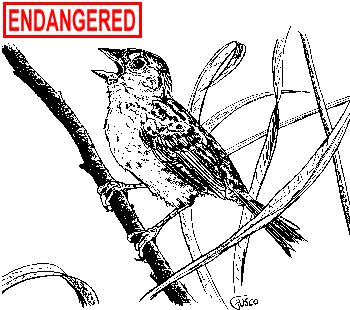Grasshopper Sparrow
Ammodramus savannarum

Habitat: Grasslands, pastures and old fields.
Weight: 0.62 ounces.
Length: 4.5-5.25 inches.
Wingspan: 8-8.5 inches.
Life Expectancy: Banding records indicate up to 9 years of age.
Food: Insects, especially grasshoppers; also spiders, snails, earthworms, waste grain and seeds of grasses and sedges.
Status: State endangered.
Identification: Adult grasshopper sparrows are small, chunky and gray-brown above, with buffy sides and breast and a short, bristly tail. The head appears flat and the crown is dark, with a pale central stripe. The bird has a white eye-ring; a yellow-orange spot can often be seen between the eye and beak. Yellow is visible at the bend of the wings. The species is the only grassland sparrow that lacks wingbars and has no streaks or markings on its breast or sides. The sexes are similar. Juvenile sparrows have brown streaking on the breast and sides. Their song consists of 1 or 2 high chip notes followed by a brief grasshopper-like buzz; the call is a variety of squeaky and buzzy notes.
Range: The breeding range extends from southeastern British Columbia, eastern Washington and northern California east to New England and south to Florida and Central America. Grasshopper sparrows winter from South Carolina to Florida, west to southern Arizona and extending south to Mexico and Central America.
Reproduction: The grasshopper sparrow breeds in late May and early June and usually raises 2 or 3 broods per year. The nest is a cup of stems and grass blades lined with fine grasses, rootlets and hair, and built on the ground in a small hollow at the base of a plant tuft. The rim of the nest is usually level with or slightly above the ground. The 4 to 5 elliptical, smooth, glossy white eggs have reddish-brown speckles and blotches that are concentrated at the larger end and sparse elsewhere. The female incubates the eggs for 11 to 12 days and tends the nestlings after they hatch. The male defends the nest from predators. After 9 days, the young leave the nest but are unable to fly. Until their flight feathers grow out, the young run through the grass to avoid disturbance.
Reason for Decline: Grasshopper sparrows have steadily declined as dry, grassy uplands and farms have reverted to forests or have been replaced by developments. As with other ground-nesting birds, high populations of predators like raccoons, skunks and feral or free-roaming housecats have also contributed to this species' decline.
History in Connecticut: The grasshopper sparrow was an abundant nester in Connecticut in the mid-1800s, but populations declined around 1900. Although the species remained locally abundant until the 1930s, populations have declined steadily since, and the bird is now only found in a few locations statewide.
Interesting Facts: Grasshopper sparrows have hybridized with savannah sparrows; a hybrid female was documented in 1968.
Both males and females sing; males often sing at night. The birds are most often seen during migration and the breeding season.
The grasshopper sparrow has historically been called the yellow-winged sparrow because of the yellow feathers found at the bend in the wings.
Protective Legislation: Federal - Migratory Bird Treaty Act of 1918. State - Connecticut General Statutes Sec. 26-311.
What You Can Do: Protection of open, grassland areas is essential to maintaining breeding populations of grasshopper sparrows. Maintaining fields and remaining at a distance from nests can also help this species.

The production of this Endangered and Threatened Species Fact Sheet
Series is made possible by donations to the Endangered Species/Wildlife Income Tax
Checkoff Fund.
(rev. 12/99)

